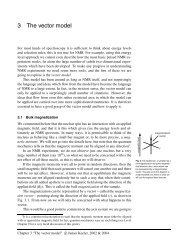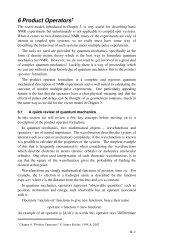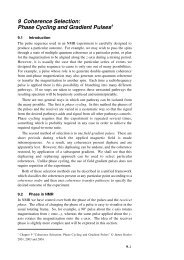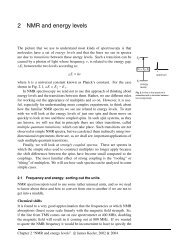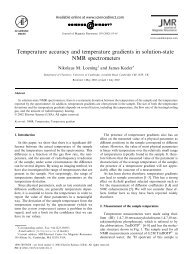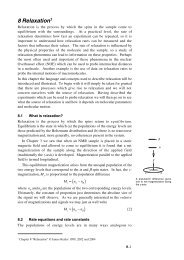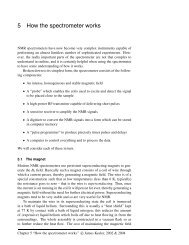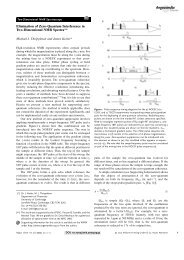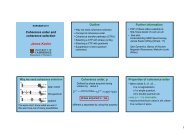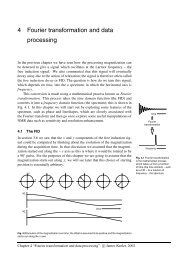Phase Cycling and Gradient Pulses - The James Keeler Group
Phase Cycling and Gradient Pulses - The James Keeler Group
Phase Cycling and Gradient Pulses - The James Keeler Group
Create successful ePaper yourself
Turn your PDF publications into a flip-book with our unique Google optimized e-Paper software.
<strong>and</strong> (b) are in every other respect equivalent, thus there is no reason not to<br />
chose (a). It should be emphasised that diffusion weighting occurs only when t 1<br />
intervenes between the dephasing <strong>and</strong> refocusing gradients.<br />
9.6.7 Some examples of gradient selection<br />
9.6.7.1 Introduction<br />
Reference has already been made to the two general advantages of using<br />
gradient pulses for coherence selection, namely the possibility of a general<br />
improvement in the quality of spectra <strong>and</strong> the removal of the requirement of<br />
completing a phase cycle for each increment of a multi-dimensional<br />
experiment. This latter point is particularly significant when dealing with<br />
three- <strong>and</strong> four-dimensional experiments.<br />
<strong>The</strong> use of gradients results in very significant improvement in the quality of<br />
proton-detected heteronuclear experiments, especially when unlabelled samples<br />
are used. In such experiments, gradient selection results in much lower<br />
dynamic range in the free induction decay as compared to phase cycled<br />
experiments.<br />
As has been discussed above, special care needs to be taken in experiments<br />
which use gradient selection in order to retain absorption mode lineshapes.<br />
In the following sections the use of gradient selection in several different<br />
experiments will be described. <strong>The</strong> gradient pulses used in these sequences will<br />
be denoted G 1<br />
, G 2<br />
etc. where G i<br />
implies a gradient of duration τ i<br />
, strength B g,i<br />
<strong>and</strong> shape factor s i<br />
. <strong>The</strong>re is always the choice of altering the duration, strength<br />
or, conceivably, shape factor in order to establish refocusing. Thus, for brevity<br />
we shall from now on write the spatially dependent phase produced by gradient<br />
G i<br />
acting on coherence of order p as γpG i<br />
in the homonuclear case or<br />
∑<br />
γ j<br />
pG j i<br />
j<br />
in the heteronuclear case; the sum is over all types of nucleus.<br />
9.6.7.2 Double-quantum Filtered COSY<br />
(a)<br />
(b)<br />
RF<br />
t 1<br />
G 1 G 2<br />
τ1<br />
τ 2<br />
RF<br />
t 1<br />
τ 1<br />
G 1 G 2<br />
g<br />
g<br />
2<br />
1<br />
0<br />
–1<br />
–2<br />
2<br />
1<br />
0<br />
–1<br />
–2<br />
This experiment has already been discussed in detail in previous sections;<br />
sequence (a) is essentially that described already <strong>and</strong> is suitable for recording<br />
absorption mode spectra. <strong>The</strong> refocusing condition is G 2<br />
= 2G 1<br />
; frequency<br />
9–44



